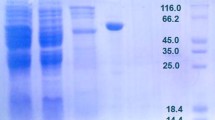Abstract
An NAD+-dependent l-arabinitol 4-dehydrogenase (LAD, EC 1.1.1.12) from Neurospora crassa was cloned and expressed in Escherichia coli and purified to homogeneity. The enzyme was a homotetramer and contained two Zn2+ ions per subunit, displaying similar characteristics to medium-chain sorbitol dehydrogenases (SDHs). High enzymatic activity was observed for substrates l-arabinitol, adonitol, and xylitol and no activity for d-mannitol, d-arabinitol, or d-sorbitol. The enzyme showed strong preference for NAD+ but also displayed a very low yet detectable activity with NADP+. Mutational analysis of residue F59, the single different substrate-binding residue between LADs and d-SDHs, failed to confer the enzyme the ability to accept d-sorbitol as a substrate, suggesting that the amino acids flanking the active site cleft may be responsible for the different activity and affinity patterns between LADs and SDHs. This enzyme should be useful for in vivo and in vitro production of xylitol and ethanol from l-arabinose.



Similar content being viewed by others
References
Banfield MJ, Salvucci ME, Baker EN, Smith CA (2001) Crystal structure of the NADP(H)-dependent ketose reductase from Bemisia argentifolii at 2.3 A resolution. J Mol Biol 306:239–250
Becker J, Boles E (2003) A modified Saccharomyces cerevisiae strain that consumes L-arabinose and produces ethanol. Appl Environ Microbiol 69:4144–4150
Bradford MM (1976) A rapid and sensitive method for the quantitation of microgram quantities of protein utilizing the principle of protein-dye binding. Anal Biochem 72:248–254
Cleland WW (1979) Statistical analysis of enzyme kinetic data. Methods Enzymol 63:103–38
de Groot MJ, Prathumpai W, Visser J, Ruijter GJ (2005) Metabolic control analysis of Aspergillus niger L-arabinose catabolism. Biotechnol Prog 21:1610–1616
Galagan JE, Calvo SE, Borkovich KA, Selker EU, Read ND, Jaffe D, FitzHugh W, Ma LJ, Smirnov S, Purcell S et al (2003) The genome sequence of the filamentous fungus Neurospora crassa. Nature 422:859–868
Hespell R (1998) Extraction and characterization of hemicellulose from the corn fiber produced by corn wet-milling processes. J Agric Food Chem 46:2615–2619
Karhumaa K, Wiedemann B, Hahn-Hagerdal B, Boles E, Gorwa-Grauslund MF (2006) Co-utilization of L-arabinose and D-xylose by laboratory and industrial Saccharomyces cerevisiae strains. Microb Cell Fact 5:18
Karlsson C, Jornvall H, Hoog JO (1995) Zinc binding of alcohol and sorbitol dehydrogenases. Adv Exp Med Biol 372:397–406
Korkhin Y, Kalb AJ, Peretz M, Bogin O, Burstein Y, Frolow F (1998) NADP-dependent bacterial alcohol dehydrogenases: crystal structure, cofactor-binding and cofactor specificity of the ADHs of Clostridium beijerinckii and Thermoanaerobacter brockii. J Mol Biol 278:967–981
Lesk AM (1995) NAD-binding domains of dehydrogenases. Curr Opin Struct Biol 5:775–83
Lindstad RI, Hermansen LF, McKinley-McKee JS (1992) The kinetic mechanism of sheep liver sorbitol dehydrogenase. Eur J Biochem 210:641–647
McMillan JD, Boynton BL (1994) Arabinose utilization by xylose-fermenting yeasts and fungi. Appl Biochem Biotechnol 45–46:569–584
Pail M, Peterbauer T, Seiboth B, Hametner C, Druzhinina I, Kubicek CP (2004) The metabolic role and evolution of L-arabinitol 4-dehydrogenase of Hypocrea jecorina. Eur J Biochem 271:1864–1872
Pauly TA, Ekstrom JL, Beebe DA, Chrunyk B, Cunningham D, Griffor M, Kamath A, Lee SE, Madura R, McGuire D et al (2003) X-ray crystallographic and kinetic studies of human sorbitol dehydrogenase. Structure 11:1071–1085
Richard P, Londesborough J, Putkonen M, Kalkkinen N, Penttila M (2001) Cloning and expression of a fungal L-arabinitol 4-dehydrogenase gene. J Biol Chem 276:40631–40637
Richard P, Verho R, Putkonen M, Londesborough J, Penttila M (2003) Production of ethanol from L-arabinose by Saccharomyces cerevisiae containing a fungal L-arabinose pathway. FEMS Yeast Res 3:185–189
Saha B, Bothast R (1996) Production of L-arabitol from L-arabinose by Candida entomaea and Pichia guilliermondii. Appl Microbiol Biotechnol 45:299–306
Saha B, Bothast R (1999) Production of xylitol by Candida peltata. J Ind Microbiol Biotechnol 22:633–636
Suzuki T, Tran LH, Yogo M, Idota O, Kitamoto N, Kawai K, Takamizawa K (2005) Cloning and expression of NAD+-dependent L-arabinitol 4-dehydrogenase gene (ladA) of Aspergillus oryzae. J Biosci Bioeng 100:472–474
Verho R, Londesborough J, Penttila M, Richard P (2003) Engineering redox cofactor regeneration for improved pentose fermentation in Saccharomyces cerevisiae. Appl Environ Microbiol 69:5892–5897
Watanabe S, Kodaki T, Makino K (2005) Complete reversal of coenzyme specificity of xylitol dehydrogenase and increase of thermostability by the introduction of structural zinc. J Biol Chem 280:10340–10349
Woodyer R, van der Donk WA, Zhao H (2003) Relaxing the nicotinamide cofactor specificity of phosphite dehydrogenase by rational design. Biochemistry 42:11604–11614
Acknowledgments
Support for this research was provided by Biotechnology Research and Development Consortium (BRDC; Project 2-4-121). Access to Insight II and MOE programs was provided by the University of Illinois School of Chemical Sciences’ Computer Application and Network Services. We thank Nikhil Nair for his help with N. crassa growth and genomic DNA manipulation.
Author information
Authors and Affiliations
Corresponding author
Electronic supplementary material
Rights and permissions
About this article
Cite this article
Sullivan, R., Zhao, H. Cloning, characterization, and mutational analysis of a highly active and stable l-arabinitol 4-dehydrogenase from Neurospora crassa . Appl Microbiol Biotechnol 77, 845–852 (2007). https://doi.org/10.1007/s00253-007-1225-0
Received:
Revised:
Accepted:
Published:
Issue Date:
DOI: https://doi.org/10.1007/s00253-007-1225-0




